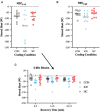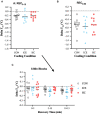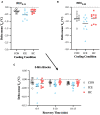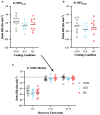An Ice Vest, but Not Single-Hand Cooling, Is Effective at Reducing Thermo-Physiological Strain During Exercise Recovery in the Heat
- PMID: 33997780
- PMCID: PMC8117958
- DOI: 10.3389/fspor.2021.660910
An Ice Vest, but Not Single-Hand Cooling, Is Effective at Reducing Thermo-Physiological Strain During Exercise Recovery in the Heat
Abstract
Sports limit the length of breaks between halves or periods, placing substantial time constraints on cooling effectiveness. This study investigated the effect of active cooling during both time-limited and prolonged post-exercise recovery in the heat. Ten recreationally-active adults (VO2peak 43.6 ± 7.5 ml·kg-1·min-1) were exposed to thermally-challenging conditions (36°C air temperature, 45% RH) while passively seated for 30 min, cycling for 60 min at 51% VO2peak, and during a seated recovery for 60 min that was broken into two epochs: first 15 min (REC0-15) and total 60 min (REC0-60). Three different cooling techniques were implemented during independent recovery trials: (a) negative-pressure single hand-cooling (~17°C); (b) ice vest; and (c) non-cooling control. Change in rectal temperature (T re), mean skin temperature ( ), heart rate (HR), and thermal sensation (TS), as well as mean body temperature ( ), and heat storage (S) were calculated for exercise, REC0-15 and REC0-60. During REC0-15, HR was lowered more with the ice vest (-9 [-15 to -3] bts·min-1, p = 0.002) and single hand-cooling (-7 [-13 to -1] bts·min-1, p = 0.021) compared to a non-cooling control. The ice vest caused a greater change in compared to no cooling (-1.07 [-2.00 to -0.13]°C, p = 0.021) and single-hand cooling (-1.07 [-2.01 to -0.14]°C, p = 0.020), as well as a greater change in S compared to no cooling (-84 [-132 to -37] W, p < 0.0001) and single-hand cooling (-74 [-125 to -24] W, p = 0.002). Across REC0-60, changes in (-0.38 [-0.69 to -0.07]°C, p = 0.012) and (-1.62 [-2.56 to -0.68]°C, p < 0.0001) were greater with ice vest compared to no cooling. Furthermore, changes in in (-0.39 [-0.70 to -0.08]°C, p = 0.010) and (-1.68 [-2.61 to -0.74]°C, p < 0.0001) were greater with the ice vest compared to single-hand cooling. Using an ice vest during time-limited and prolonged recovery in the heat aided in a more effective reduction in thermo-physiological strain compared to both passive cooling as well as a single-hand cooling device.
Keywords: core temperature; exercise in heat; heat storage; post-exercise recovery; skin temperature; sport; thermoregulation.
Copyright © 2021 Seeley and Sherman.
Conflict of interest statement
The authors declare that the research was conducted in the absence of any commercial or financial relationships that could be construed as a potential conflict of interest.
Figures





Similar articles
-
Practical Torso Cooling During Soccer-Specific Exercise in the Heat.J Athl Train. 2018 Nov;53(11):1089-1097. doi: 10.4085/1062-6050-417-17. Epub 2019 Jan 7. J Athl Train. 2018. PMID: 30615489 Free PMC article.
-
Effects of mixed-method cooling between exercise bouts on thermoregulation and cycling time-trial performance in the heat.J Therm Biol. 2022 Oct;109:103329. doi: 10.1016/j.jtherbio.2022.103329. Epub 2022 Sep 14. J Therm Biol. 2022. PMID: 36195393
-
The impact of different cooling modalities on the physiological responses in firefighters during strenuous work performed in high environmental temperatures.Eur J Appl Physiol. 2011 Jun;111(6):959-67. doi: 10.1007/s00421-010-1714-1. Epub 2010 Nov 16. Eur J Appl Physiol. 2011. PMID: 21079990 Clinical Trial.
-
Influence of acute heat mitigation strategies on core temperature, heart rate and aerobic performance in females: A systematic literature review.J Sports Sci. 2024 Aug;42(16):1491-1511. doi: 10.1080/02640414.2024.2396225. Epub 2024 Sep 11. J Sports Sci. 2024. PMID: 39262133
-
Optimizing Cold-Water Immersion for Exercise-Induced Hyperthermia: An Evidence-Based Paper.J Athl Train. 2016 Jun 2;51(6):500-1. doi: 10.4085/1062-6050-51.9.04. Epub 2016 Jul 21. J Athl Train. 2016. PMID: 27441949 Free PMC article. Review.
Cited by
-
Recovery with a fan-cooling jacket after exposure to high solar radiation during exercise in hot outdoor environments.Front Sports Act Living. 2023 Feb 13;5:1106882. doi: 10.3389/fspor.2023.1106882. eCollection 2023. Front Sports Act Living. 2023. PMID: 36860733 Free PMC article.
References
-
- Balldin U., Whitmore J., Harrison R., Fisher D., Fischer J., Stork R. (2007). The effects of a palm cooling device and a cooling vest during simulated pilot heat stress, in Air Force research laboratory: Interim Report for October 2005 to January 2007. Brooks-City-Base, TX.
LinkOut - more resources
Full Text Sources
Other Literature Sources
Miscellaneous

